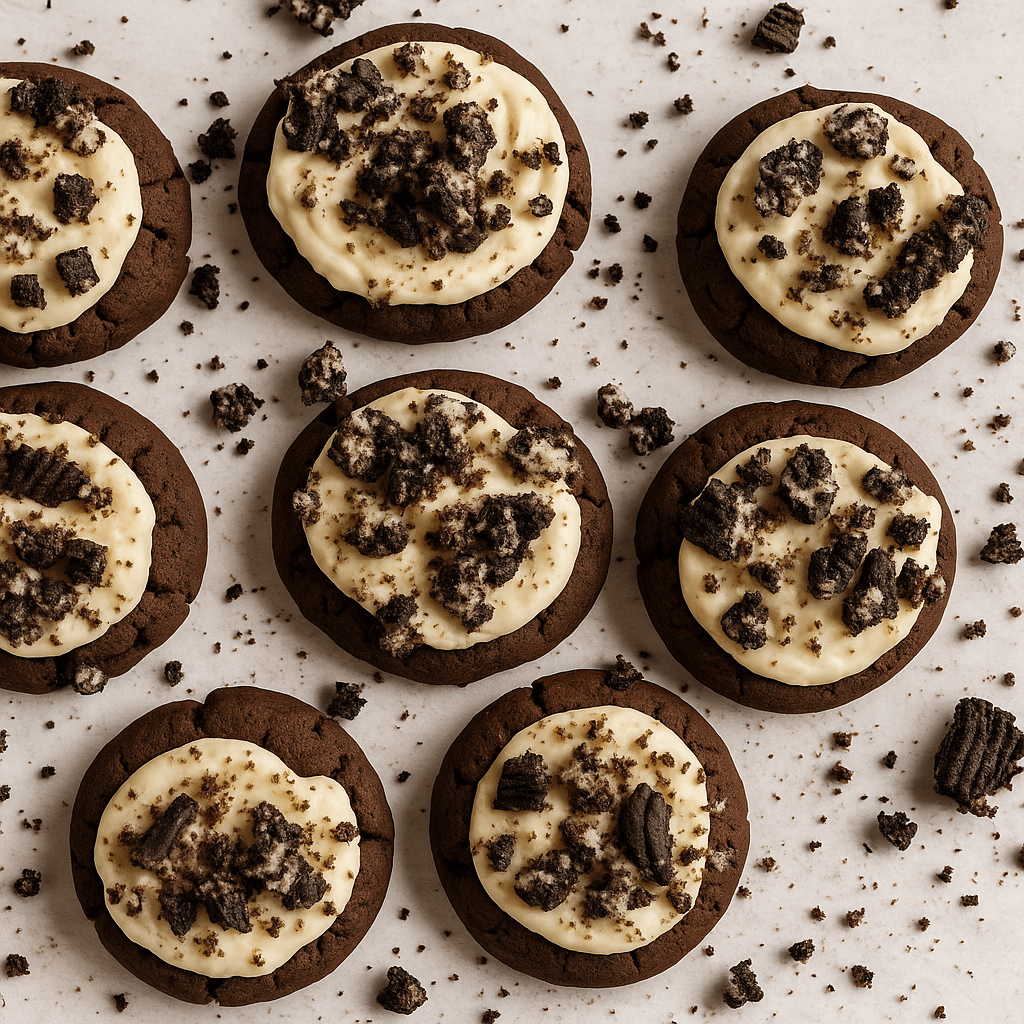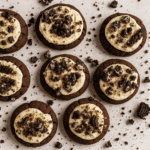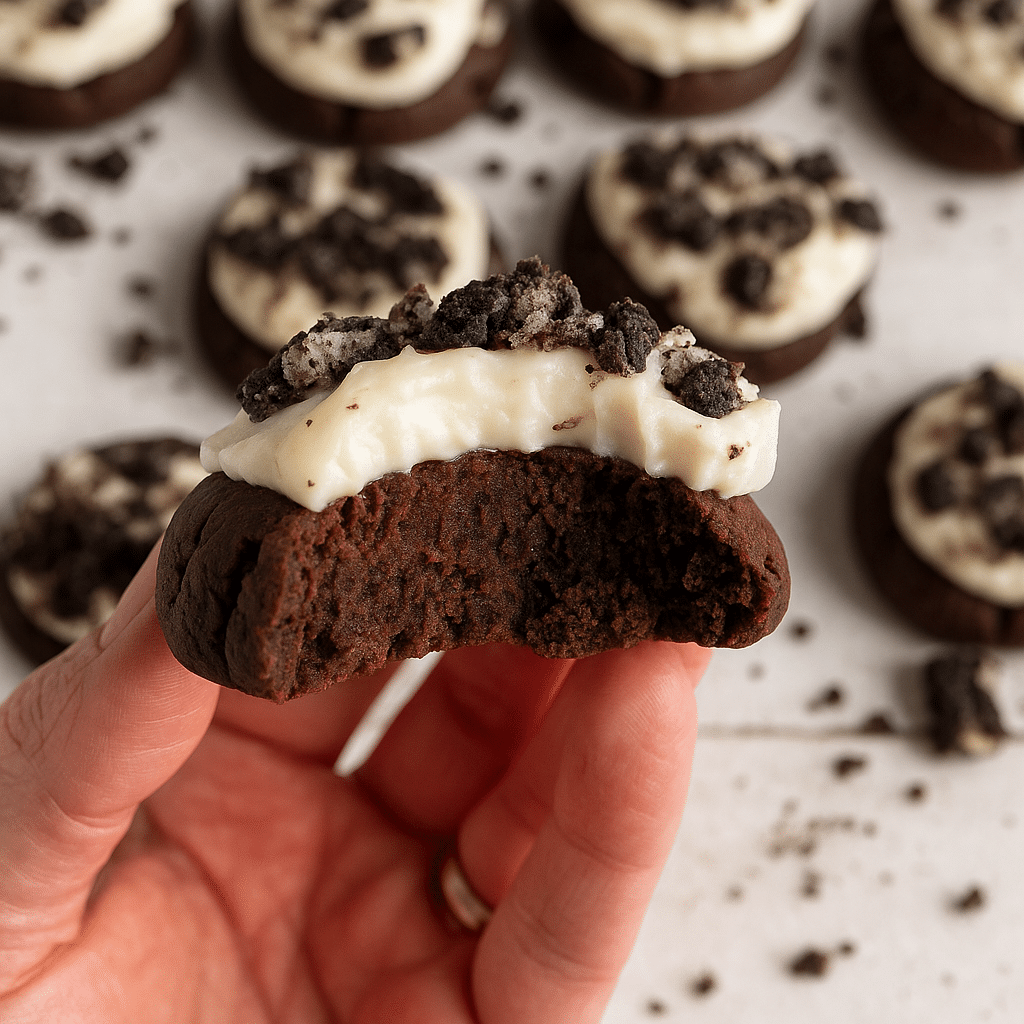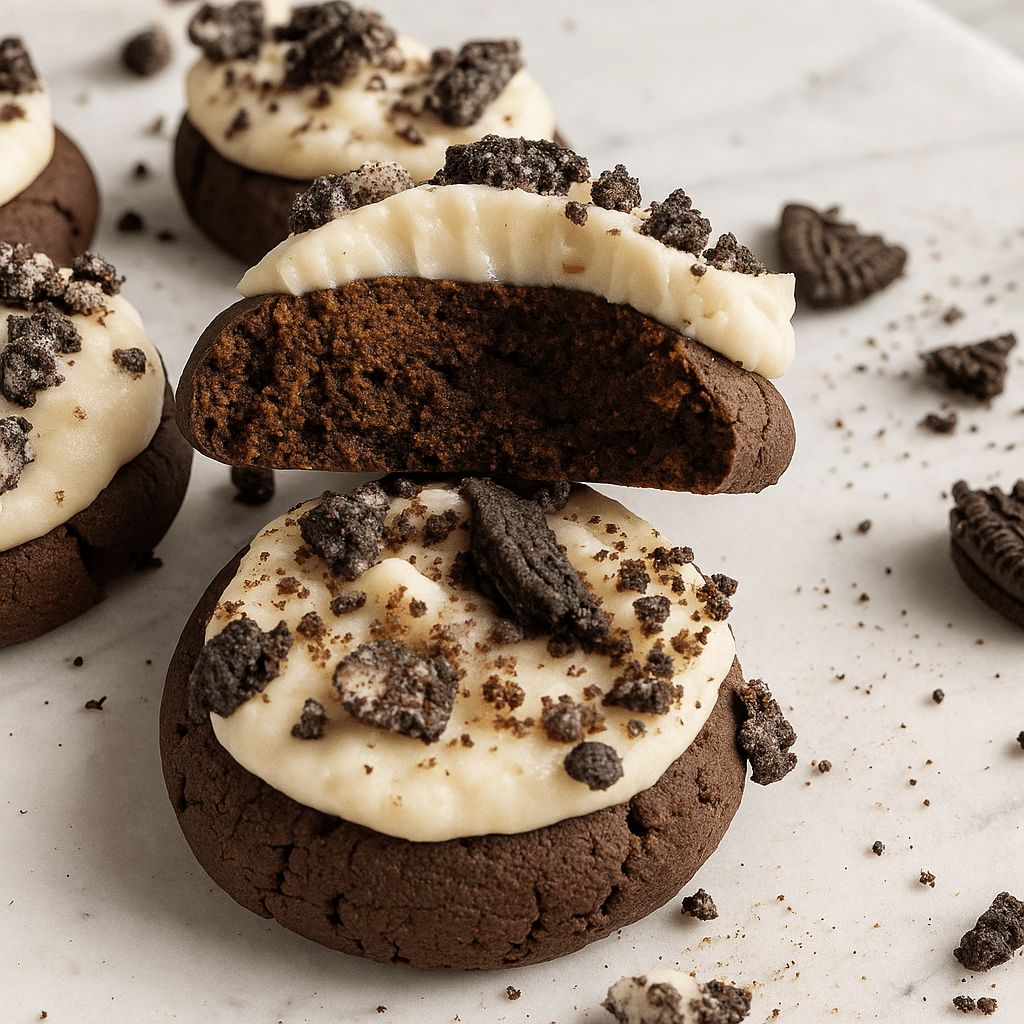Cookies and cream protein cookies were the first healthy dessert my kids actually got excited about. I made them one rainy afternoon, hoping to sneak in something nourishing without the usual complaints. But one bite of that rich chocolate base and creamy topping—and suddenly, I was the cool mom with the “good” cookies.

What makes cookies and cream protein cookies so special? They’re gluten-free, dairy-free, flourless, and packed with plant-based protein—making them a smart, satisfying choice for anyone craving a clean dessert. Whether you’re meal prepping, post-gym snacking, or just love a good cookie with a twist, these protein-packed treats are proof that healthy can still feel indulgent.
Table of Contents
Why Cookies and Cream Protein Cookies Are a Smart Snack Choice
A Better Way to Curb Sweet Cravings
Instead of reaching for sugar-heavy snacks, cookies and cream protein cookies offer a cleaner option. With fewer carbs and more protein, they satisfy cravings without the crash. You get that same indulgent bite—just with better ingredients.
High-protein treats like these also help curb hunger and support recovery, making them perfect post-gym or as a midday pick-me-up.
Why Cookies and Cream Is the Perfect Flavor
The combo of rich chocolate and creamy vanilla makes cookies and cream protein cookies a fan favorite. It’s nostalgic and satisfying, with just the right balance of taste and texture.
Plus, modern protein powders come in gourmet flavors like cookies and cream—great for baking without that “chalky” taste. Paired with cocoa and a sugar-free frosting, these cookies are proof that healthy can still feel indulgent.
Print
Cookies and Cream Protein Cookies That Actually Taste Amazing
- Total Time: 20 minutes
- Yield: 10–12 cookies 1x
Description
Sweet, simple, and protein-packed—these cookies and cream protein cookies are a must-try! Gluten-free, dairy-free, flourless, and rich in plant-based protein, they’re a clean dessert that actually tastes indulgent.
Ingredients
- 1/2 cup almond butter (or sunflower seed butter)
- 2 tbsp vegan butter or coconut oil
- 1 egg white (or flax egg or aquafaba)
- 1 tsp vanilla extract
- 1/4 cup low-glycemic sweetener (erythritol, monk fruit, or coconut sugar)
- 1/2 cup cookies & cream protein powder (vegan or whey)
- 2 tbsp dark cocoa powder
- Pinch of sea salt
- 1/4 cup dairy-free cream cheese
- 2 tbsp sugar-free powdered sweetener
- 1/4 tsp vanilla extract (for frosting)
- Crushed chocolate sandwich cookies (gluten-free if needed)
Instructions
- Preheat oven to 350°F (175°C) and line a baking sheet with parchment paper.
- In a medium bowl, mix almond butter, vegan butter, egg white, vanilla extract, and sweetener until smooth.
- Add in protein powder, cocoa powder, and a pinch of salt. Stir until dough is thick and slightly sticky.
- Form dough into 1–2 tbsp-sized balls and flatten slightly on baking sheet.
- Bake for 8–10 minutes, then let cool completely on a rack.
- For the frosting, blend cream cheese, powdered sweetener, and vanilla extract until smooth.
- Frost cooled cookies and top with crushed chocolate sandwich cookies.
Notes
For best texture, refrigerate dough 20–30 minutes before baking. Store frosted cookies in the fridge for up to 7 days or freeze for up to 2 months.
- Prep Time: 10 minutes
- Cook Time: 10 minutes
- Category: Healthy Dessert
- Method: Baking
- Cuisine: American
Nutrition
- Serving Size: 1–2 cookies
- Calories: 150–180
- Sugar: 1–3g
- Sodium: 120mg
- Fat: 6–8g
- Saturated Fat: 2.5g
- Unsaturated Fat: 5g
- Trans Fat: 0g
- Carbohydrates: 8–10g
- Fiber: 2g
- Protein: 10–12g
- Cholesterol: 0–5mg
Keywords: cookies and cream, protein cookies, healthy dessert, gluten-free, dairy-free, plant-based protein
Nutritional Value of Cookies and Cream Protein Cookies
Macro Breakdown: Protein, Carbs, and Fats
What sets cookies and cream protein cookies apart from traditional cookies is their nutrient profile. While a regular cookie can be high in sugar and empty calories, protein cookies are designed to be more balanced. Let’s break down the macros in an average serving (1–2 cookies):
| Nutrient | Approximate Amount |
|---|---|
| Protein | 10–12 grams |
| Carbohydrates | 8–10 grams |
| Fats | 6–8 grams |
| Sugar | 1–3 grams |
| Calories | 150–180 kcal |
These values can vary based on ingredients, but when you use plant-based or whey protein and low-glycemic sweeteners, you’re getting a treat that fuels energy without the crash.
Key Ingredients That Make It Nutritious
Here’s a breakdown of the star ingredients that help boost the nutritional value of these cookies:
- Pea or whey protein powder: Adds high-quality, complete protein to support muscle recovery and satiety.
- Cacao or dark cocoa powder: Rich in antioxidants like polyphenols, which may help reduce inflammation.
- Almond or sunflower seed butter: Healthy fats that support brain function and hormone balance.
- Sugar alternatives (erythritol, monk fruit, or stevia): These provide sweetness without the blood sugar spike.
- Egg white or vegan replacer: Delivers structure and adds to the protein content.
Because these cookies are often gluten-free and dairy-free, they’re also more digestible for people with food sensitivities. Plus, you’re not loading your body with artificial preservatives or fillers, which makes them a cleaner option overall.
How to Make Cookies and Cream Protein Cookies at Home
Essential Ingredients and Smart Substitutions
One of the biggest perks of making cookies and cream protein cookies at home is total control over the ingredients. Whether you’re following a vegan lifestyle, avoiding gluten, or simply want a high-protein treat, this recipe is easy to adjust to your needs.
Let’s break down the essentials that go into baking great-tasting cookies and cream protein cookies:
- Cookies & Cream Protein Powder: Use a vegan blend (like pea protein) for the best texture. If using whey, consider adding a small amount of flour, since whey tends to absorb less moisture.
- Dark Cocoa Powder: A high-quality Special Dark or Dutch-processed cocoa powder intensifies the chocolate base.
- Nut Butter: Almond butter gives a creamy texture. You can substitute sunflower seed butter or tahini to make your cookies nut-free.
- Vegan Butter or Coconut Oil: These fats help achieve that rich, bakery-style softness. Unsalted dairy butter also works if you’re not keeping the cookies dairy-free.
- Low-Glycemic Sweetener: Erythritol, monk fruit, or coconut sugar blends are ideal for keeping cookies and cream protein cookies low in sugar but full of flavor.
- Egg White or Vegan Alternative: Use egg whites for added structure and protein. For a vegan batch, try flaxseed meal mixed with warm water or aquafaba.
- Vanilla Extract: Just a splash brings balance to the chocolate and cream flavors.
For the frosting and topping, which make cookies and cream protein cookies truly crave-worthy:
- Dairy-Free Cream Cheese: Mix with powdered sweetener and vanilla for a creamy, sugar-free frosting.
- Crushed Chocolate Sandwich Cookies: Whether you go for gluten-free Oreos or another brand, this final touch gives your cookies that classic cookies-and-cream vibe.
Step-by-Step Preparation Instructions
Making cookies and cream protein cookies is simple—even fun! Here’s how to do it:
1. Preheat Your Oven
Set your oven to 350°F (175°C). Line a baking sheet with parchment paper.
2. Mix Wet Ingredients
In a medium bowl, combine the almond butter, vegan butter (or coconut oil), egg white (or vegan substitute), vanilla extract, and sweetener. Stir until the mixture is smooth and creamy.
3. Add Dry Ingredients
Fold in the cookies and cream protein powder, cocoa powder, and a pinch of sea salt. The dough should be thick and slightly sticky—perfect for forming soft cookies.
4. Shape the Dough
Scoop out 1–2 tablespoons of dough and shape into small balls. Place on the baking sheet and flatten each slightly with a spoon or your palm.
5. Bake the Cookies
Place in the oven and bake for 8–10 minutes. Don’t worry if they seem soft—they’ll set as they cool.
6. Cool and Frost
Let the cookies cool completely on a rack. While they cool, whip up your frosting: blend dairy-free cream cheese, sugar-free powdered sweetener, and a touch of vanilla extract.
7. Add the Final Touch
Once the cookies are cool, spread frosting on each and sprinkle with crushed chocolate sandwich cookies. This step is what really gives cookies and cream protein cookies their irresistible look and taste.
Homemade cookies and cream protein cookies can be stored in the fridge for 5–7 days, or frozen for up to a month. They’re great for snacking, dessert, or even as part of your weekly meal prep.

Choosing the Right Protein for Your Cookies
Vegan Protein vs Whey Protein: Which Works Better?
When baking cookies and cream protein cookies, the type of protein powder you use can make or break your final result. The two most common choices—vegan protein and whey protein—each have pros and cons depending on your dietary needs and texture preferences.
Vegan protein, especially pea protein isolate, tends to absorb more moisture and creates a thick, fudgy dough. It’s perfect for those who want a soft and chewy cookie that holds together well. Vegan proteins also pair nicely with dairy-free or gluten-free diets, making them the top choice for allergen-friendly baking.
On the other hand, whey protein (either concentrate or isolate) offers a smoother taste and faster mixability, but it can dry out your cookies if not balanced with enough fat or flour. If you opt for whey in your cookies and cream protein cookies, you may need to add almond flour or a small amount of oat flour to offset the lower absorption rate.
| Comparison | Vegan Protein | Whey Protein |
|---|---|---|
| Texture | Thick, chewy | Light, can be dry |
| Absorption | High moisture binding | Low moisture binding |
| Flavor Base | Slightly earthy | Creamy, mild |
| Best For | Dairy-free, GF baking | Soft, fluffy cookies |
Best Protein Powders for Baking Cookies
Not all protein powders are created equal. For successful cookies and cream protein cookies, go with a powder that blends well and doesn’t overpower the flavor.
Here are a few tried-and-true options for baking:
- LIV Body Lean Vegan Protein (Cookies & Cream): A favorite for its clean formula, probiotic boost, and rich flavor.
- Orgain Organic Protein Powder: Great for soft textures and plant-based diets.
- Optimum Nutrition Gold Standard Whey: Reliable whey option, just add a bit of almond flour when using in cookie dough.
- Clean Simple Eats Protein: Comes in unique dessert flavors and bakes well into cookies.
When selecting your powder, avoid blends that contain added gums, artificial flavors, or high sodium. These can affect the taste and consistency of your cookies and cream protein cookies. Always check the ingredient list—and when in doubt, test a half-batch before committing!
Sweeteners and Add-ins for Flavor and Texture
Healthier Sweetener Options
To keep your cookies and cream protein cookies low in sugar and high in flavor, it’s best to skip traditional sugar. Here are some great alternatives:
- Erythritol – Bakes like sugar and has no calories.
- Monk Fruit Blends – Sweet and clean with no bitter aftertaste.
- Coconut Sugar – Slightly lower glycemic than white sugar with a hint of caramel flavor.
- Brown Sugar Substitutes – Great for chewy texture and richer taste.
These sweeteners work well in cookie dough and frosting without causing spikes in blood sugar.
Flavor-Boosting Add-ins
Add-ins can take cookies and cream protein cookies to the next level. These are the most popular:
- Crushed Chocolate Sandwich Cookies – The must-have topping.
- Dark Chocolate Chips – Use low-sugar or dairy-free brands.
- Nuts or Seeds – Add crunch and healthy fats.
- Coconut or Cacao Nibs – Great texture and nutrition.
Frosting made with dairy-free cream cheese, powdered sweetener, and vanilla pairs perfectly with cookie crumbles on top. These mix-ins not only boost flavor, but they make your cookies more satisfying and fun to eat.
PART 6: Gluten-Free and Dairy-Free Options
Making Cookies Safe for Gluten-Free and Dairy-Free Diets
If you’re following a gluten-free or dairy-free diet, you can still enjoy cookies and cream protein cookies without compromising on flavor or texture. With just a few smart swaps, these cookies stay indulgent while being gentle on digestion.
Here’s how to do it:
- Flourless Formula: Many recipes for cookies and cream protein cookies skip flour entirely, relying on protein powder and cocoa for structure. This makes them naturally gluten-free—no specialty flours required.
- Use Gluten-Free Sandwich Cookies: Not all chocolate sandwich cookies are gluten-free, so choose certified GF brands or options made from rice flour or almond flour.
- Pick Dairy-Free Protein Powder: Vegan proteins (like pea or brown rice blends) are both dairy-free and easy to bake with. Cookies and cream flavors are widely available in plant-based versions.
- Ditch the Butter: Instead of dairy butter, use vegan butter, coconut oil, or coconut butter. These add richness while keeping your recipe dairy-free.
Best Substitutes for Sensitive Stomachs
If you or your family have food sensitivities, here are a few other easy substitutions that work well:
| Ingredient | Substitution |
|---|---|
| Egg White | Flax egg or aquafaba |
| Almond Butter | Sunflower seed butter or tahini |
| Cream Cheese (frosting) | Kite Hill, Miyoko’s, or Tofutti |
| Sandwich Cookies | Simple Mills, Kinnikinnick, or homemade |
These adjustments won’t change the delicious cookies-and-cream flavor you’re aiming for. In fact, they make your cookies and cream protein cookies more inclusive—so everyone can enjoy a healthy dessert.
Tips for Perfect Texture and Taste
Avoiding Common Protein Cookie Mistakes
Making cookies and cream protein cookies taste as good as they sound takes a little finesse. Protein powder changes the chemistry of cookie dough, so if you’re not careful, your batch can turn out dry or rubbery.
Here’s how to avoid the most common mistakes:
- Don’t Overmix the Dough: Protein powder becomes dense when overworked. Mix until just combined to keep your cookies tender.
- Measure Protein Precisely: Too much powder makes cookies gritty. Stick to recipe measurements.
- Use Enough Moisture: Nut butters, vegan butter, or even a splash of plant milk can help maintain chewiness.
- Let Them Cool Fully: These cookies firm up as they cool. Don’t judge them straight from the oven—they’ll feel soft at first.
These tips help bring out the best in your cookies and cream protein cookies—soft in the middle, lightly crisp around the edges, and never chalky.
Balancing Crunch, Cream, and Chew
Texture is what separates a good cookie from a great one. For that signature bite:
- Use crunchy sandwich cookie crumbles on top and slightly in the dough.
- Add a creamy frosting to contrast the crisp base.
- Underbake slightly, then let them sit to finish cooking on the tray.
- Refrigerate the dough for 20–30 minutes before baking—this makes a big difference in texture.
When you get the right balance of chewiness, richness, and crunch, your cookies and cream protein cookies will taste just as indulgent as the store-bought kind—only cleaner and way more satisfying.
Storage, Meal Prep, and Serving Ideas
Storing Cookies the Right Way
To keep your cookies and cream protein cookies fresh and delicious:
- Room Temp: Store unfrosted in an airtight container for up to 2 days.
- Fridge: Keep frosted cookies refrigerated for up to 7 days.
- Freezer: Freeze for up to 2 months in layers with parchment paper. Thaw before serving.
Proper storage helps maintain the chewy texture and rich flavor that make these cookies stand out.
Easy Serving Ideas
These cookies aren’t just for dessert—they’re versatile, clean snacks. Try them:
- As a post-workout treat for protein and satisfaction.
- Crumbled over yogurt or smoothie bowls.
- Packed in lunchboxes or enjoyed with almond milk.
- On a healthy dessert platter with fruit and dark chocolate.
With smart prep and creative pairings, cookies and cream protein cookies can be more than just a sweet treat—they’re part of your lifestyle.
Comparing Store-Bought vs Homemade Protein Cookies
Nutrition and Ingredient Comparison

Both store-bought and homemade cookies and cream protein cookies can be tasty, but when it comes to health, ingredients, and cost—homemade often wins.
Here’s how they stack up:
| Feature | Store-Bought Cookies | Homemade Protein Cookies |
|---|---|---|
| Protein Content | 8–10g per cookie | 10–12g (adjustable) |
| Sugar Content | Often 5–10g, even in “healthy” ones | 1–3g with sugar alternatives |
| Sweeteners Used | Often artificial or high-fructose | Natural: monk fruit, erythritol, coconut sugar |
| Fats | May include palm or hydrogenated | Healthy fats like almond butter, coconut oil |
| Customization | Limited | Total control—vegan, gluten-free, low-carb etc. |
| Cost per Serving | $2.50–$4.00 | $0.75–$1.25 |
Why Homemade Wins for Flavor and Flexibility
When you make cookies and cream protein cookies at home, you choose what goes in—and what stays out. You can skip preservatives, adjust the macros, and even change the texture or sweetness. Plus, fresh-baked cookies always beat pre-packaged ones on flavor.
And if you’re baking for kids, family members with allergies, or meal prepping for the week, homemade is the smarter (and cheaper) way to go.
So while store-bought options are convenient, homemade protein cookies give you more nutrition, better taste, and real ingredients you can trust.
Conclusion
If you’re looking for a dessert that satisfies your sweet tooth and supports your wellness goals, cookies and cream protein cookies are the ultimate answer. They’re rich, chewy, customizable, and packed with clean, simple ingredients. Whether you’re baking for yourself, your kids, or your fitness journey, these cookies prove that healthy doesn’t have to mean boring.
Skip the store-bought snacks with preservatives and added sugars. With this guide, you can whip up your own protein-packed treat that tastes like dessert but fuels like a snack. Once you try cookies and cream protein cookies, you’ll never look at regular cookies the same way again.
Want more healthy recipes and baking ideas? Follow us on Facebook and get inspired by our latest creations on Pinterest!
FAQs About Cookies and Cream Protein Cookies
Are protein cookies actually healthy?
Yes—when made with clean ingredients, protein cookies are a healthier option than regular cookies. They’re often lower in sugar, higher in protein, and free of refined flour. Homemade cookies and cream protein cookies are especially good because you control what goes in.
What can I mix with cookies and cream protein powder?
You can mix cookies and cream protein powder into smoothies, yogurt, oatmeal, or cookie dough. It’s perfect for recipes like cookies and cream protein cookies, adding flavor and nutrition.
Is the cookies and cream Premier Protein good?
Premier Protein’s cookies and cream flavor is tasty for a shake and high in protein, but not ideal for baking. For making cookies and cream protein cookies, use a quality baking-friendly protein powder instead.
Can I add protein powder to my cookies?
Yes! Protein powder works great in cookie recipes. Just adjust moisture levels to avoid dryness. It’s key in recipes like cookies and cream protein cookies to keep them soft and chewy.